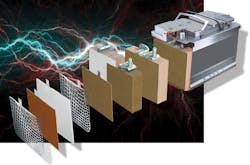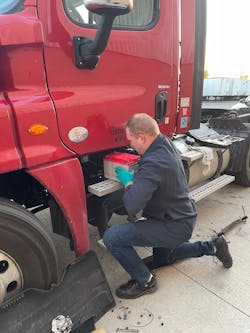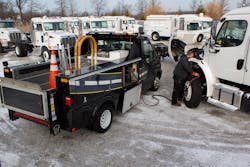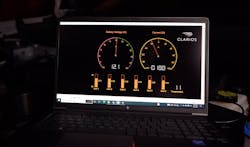Even for new technicians—or even amateur mechanics—the vehicle battery has been one of the easier components to troubleshoot and replace. Working with electrical systems should never be taken lightly, but if you follow the right steps, it’s all pretty straightforward. But over the last several years the rest of the vehicle—particularly the systems that feed off the battery—have become more complex and smarter, with electric trucks here and autonomous ones not far off.
And because of this, batteries too must increase their IQ, and that effort is well underway at several leading battery manufacturers.
Read more: How to prolong and maintain modern CV batteriesAccording to Craig Rigby, Clarios VP of technology, improving battery intelligence “is one of the next frontiers” and will enable more autonomy and optimize vehicles’ electrical architecture “for the sake of reliability, performance, and cost.”
And as vehicle safety evolves, Rigby noted the level and quality of power supplied by the battery is just as critical. Clarios is making its batteries more intelligent by improving internal sensing and how that is communicated to the vehicle.
This has been enabled by using Absorbent Glass Mat (AGM) technology as opposed to a standard lead-acid batteries. AGM batteries are more costly, but have several benefits, including lighter weight, more robustness, faster charging time, and the ability to better withstand lower temperatures. They do need to be completely charged or they will lose capacity over time.
“Truck AGM batteries are designed to deliver high cranking power, ensuring reliable starting in even the coldest of temperatures, and high capacity to support the increasing hotel requirements of today’s trucks,” explained John Bania, Clarios managing director for heavy duty/non-automotive global CBU. “Clarios has also developed batteries with technology that enables them to recover quickly from deep discharges, providing uninterrupted power to the vehicle’s electrical system.”
Bania noted that Clarios has leveraged these benefits within the Smart AGM solution, which “allows fleet managers, technicians, and drivers to monitor battery health in real time.”
As an active, real-time monitoring system, Smart AGM technology identifies weak cells that eventually drain battery life, provides a predictive assessment, and sends performance alerts to fleet management systems so fleets can proactively plan for replacement. Smart AGM batteries will enter limited production in 2023 and are currently being tested by fleets. They will be in full production in 2024.
The technology might also mean the end of dead batteries, as the new communication gives the system “the ability to predict when a replacement needs to be made before a roadside failure reduces downtime,” Bania explained.
Clarios is one of many battery OEs boosting batteries’ brain power.
“Battery intelligence is something we are working hard on integrating,” said Bryce Gregory, systems product manager for transportation and specialty at EnerSys, which produces Odyssey batteries. “Our Odyssey Connect solution helps identify problems with batteries and battery packs on trucks to help solve problems before the vehicle goes back out on the road. We’re also working on making this solution more dynamic, predictive, and easier to use to help reduce the opportunity for field failures.”
This is exactly what fleets have been asking for.
“We’re seeing customers expect more than just plain batteries; they expect smart batteries that can operate in a system and provide optimum performance and reliability,” said Landon Self, director, of administration, ZeroRPM at Mission Critical Electronics.
MCE owns power solutions provider Xantrex, a company which produces the Freedom eGEN lithium-ion battery-based power system, and has focused on new ways to optimize electrical system controls.
“Xantrex / ZeroRPM APU batteries are intelligent systems that can control other components on a vehicle like the alternator for optimum charging; an inverter, for powering tools and equipment; a solar controller for charging without shore power or the engine running, and vehicle interfacing for safety and performance.”
Advanced solutions for more complex trucks
“As commercial trucks become more advanced and the shift toward electric and autonomous vehicles accelerates, we are continuing the development of advanced low voltage energy storage solutions to support those changes,” Bania said. “And for non-Smart AGM batteries, we are working on sensor-based solutions to identity battery-related issues in the field and assist technicians in their assessments.”
Non-spillable AGM batteries, manufactured with Thin Plate Pure Lead (TPPL) technology, are purpose-built for fleet use, noted Bryce Gregory.
“Odyssey batteries provide great cranking power, even on the coldest of days, and the ability to recover from deep discharges and cycle many hundreds of times,” he said. “These batteries also feature refined application battery chemistry for fleet applications, as well as work in new applications like auxiliary energy storage for safety-critical applications in autonomous and electric vehicles.”
Interstate Batteries, a provider of commercial batteries, offers products for several vehicle applications. The manufacturer’s AGM batteries provide high cranking and extreme deep-cycle power needed in modern heavy-duty trucks. The 2-in-1 pure lead AGM technology, according to the company, delivers a service life three times longer than conventional flooded batteries and twice as long as alloyed lead AGM batteries.
Interstate also offers starting batteries with a range of low to high cranking power such as the company’s Group 31 batteries, which can produce more than 300 medium-duty cycles. Additionally, the company makes high-cycling batteries for moderate cranking needs and power for liftgates, lights, APUs, and other cab and sleeper accessories, including 520-cycle Group 31 models.
MCE’s Self pointed out that moving from lead-acid or AGM to lithium-ion batteries offers an immediate upgrade in energy density and provides for reduced size and weight.
“Our Xantrex LiFeMnPO4, which is what we call our lithium-iron battery chemistry, is inherently safe and offers electromechanical protection by automatically disconnecting if a cell voltage or temperature exceeds specified operating limits,” he related. “Each battery also has a valve to help prevent an explosion in case of puncture.”
Lithium-ion batteries offer nearly double the usable energy capacity of other battery technologies like lead-acid and AGM as they have a deeper depth of discharge, Self said. For example, AGM and flooded lead-acid batteries offer a 50% depth of discharge and Li-Ion batteries offer an 80% depth of discharge. These batteries can also be completely discharged without damage, so a 600-amp hour lithium battery provides a full 600-amp hours of usable power.
You might assume more capacity means more bulk, Self also noted, but the opposite is true. As one of the world’s lightest metal, lithium boasts a 60% to 80% weight advantage over lead. A typical Group 31 battery weighs about 75 lbs. while a similar Li-Ion battery only weighs 28 lbs.
“For common applications and use there is more traction for AGM batteries among fleets, and there are more options on the market,” said Larry Rambeaux, sales application engineer at Purkeys, a Mission Critical Electronics Brand. “At the same time, lithium chemistry batteries are gaining interest in the heavy-duty market. The technology is used in everything from rechargeable hand tools to electric vehicles, so it’s only natural that interest is growing. However, lithium-ion batteries are not a drop-in solution. Many things will have to change with the vehicle to make the technology work.”
Dead and drained batteries
A growing number of fleets are now utilizing supercapacitors. The modules can replace starting batteries or be used alongside existing batteries for powering hotel loads. Now available to fleets in the U.S. and Canada through C8 Energy is the SkelStart Engine Start Module from Skeleton Technologies.
“The supercapacitor is designed to take on the duties of engine starting and is engineered to fit in a similar dimensional envelope as a standard commercial vehicle battery,” said Jean Labrie, CEO of C8 Energy. “Replacing starter batteries with supercapacitors makes sense because it cuts down on roadside service calls, cold start problems, improves driver comfort, and with a lifespan of up to one million cycles they can theoretically outlast the vehicles.”
The SkelStart Engine Start Module is designed to crank a 27-liter engine with supercapacitor technology that delivers 2,000 cold-cranking amps. It also delivers that same starting power whether the ambient temperature is as low as -40 degrees F (-40 degrees C) or as high as 149 degrees F (65 degrees C).
“A supercapacitor is not hindered by temperature, nor is its performance impacted by extremes of cold or heat,” said Labrie. “One SkelStart can put out three times the amperage of an average lead-acid battery, and the high amperage means less system-wide exposure to the low voltage associated with depleted lead-acid batteries. Low voltage delivered by a struggling lead-acid battery can also cause higher resistance on the battery cables, which can result in starter burnouts.”
Also using supercapacitors for starting and charging 12- and 24-volt batteries on heavy-duty vehicles and a range of equipment during service calls is the Cap•Start line from Vanair featuring VSC (Vanair Super Capacitor) technology. Included in the product line are the Vanair Cap•Start 3000- Light Plus Air Compressor and Cap•Start 3000 Hydraulic Driven machines.
Cap•Start models, in conjunction with a 250-amp alternator, provide 3,000 amps of engine-starting capability. The fast-recharging VSC system can be ready to jumpstart another vehicle or piece of equipment in seconds. The units also feature user-friendly controls and a digital display for reading diagnostics, as well as a weather-protected enclosure, reverse polarity protection, and open, closed, or low circuit safety.
The need for good data and skilled techs
Regardless of the technology being used to start and power vehicles, the battery manufacturers said that good data and skilled technicians can be some of the best facilitators of fleet and industry-wide improvements.
“Correctly identified root causes and the documentation of them can lead to improved battery designs, as well as better checklists and procedures,” Gregory said. “At Odyssey we work with OEMs and fleets to provide critical on-site investigations for understanding root causes of common issues and turning those findings into training and improvements with a strong emphasis on corrective action.”
Bania noted Clarios has an extensive benchmarking and analysis program that helps understand areas needing improvement for next-generation products. “On a regular basis we bring in and tear down our products, as well as competitive products,” he explained further. “We also couple this with our data collection activities where we monitor various vehicles in real-time to better understand application drive and duty profiles. Fleets partner with us on these activities and help with access to both batteries for teardown and data collection.”
“Failure analysis is key for developing new protections and features in battery packs to respond to market demands and improve product reliability,” MCE’s Self said. “We welcome feedback from customers as a part of our product development process. To have the most intelligent batteries, we must consider many use cases across many applications and how our batteries will perform, and often our customers provide insights that are impossible to identify in a lab.”
Like anything else, Purkey’s Rambeaux noted, you can learn a lot from failed products and batteries are no different. “Tests can very easily tell if batteries have been over cycled, subjected to higher heat environments, have seen high vibration during their service life, or extended periods of time in a discharged condition,” he said. “All of these can help battery manufacturers improve their batteries for an application or recommend a different product.
“As new technology comes into the industry there will also be a lot of opportunities for shop equipment to be developed to be able to properly charge and test these new types of batteries and high voltage battery packs,” Rambeaux added. “Across the industry, basic training is still required and management needs to make sure shop policies and procedures are followed.
“Batteries have changed in many ways and have become better, but in the heavy-duty market no battery is truly maintenance-free,” Rambeaux added. “Technicians still need to know how to properly inspect, clean and test batteries.”
Battery service technicians will need basic and advanced tools as well, Self pointed out. Included are computers with CAN (Controller Area Network) connectivity, diagnostic tools, standard multi-meters for checking voltage and current on a vehicle, and common hand tools. “Technicians will also need specialized training on low-voltage, high-capacity DC circuits and an understanding of safety parameters used by battery management systems from various manufacturers,” he added.
For EnerSys’ Gregory, equipment designed for higher voltage and technicians who understand higher voltage, electric motors, energy conversion, safety, and all related PPE and tools will be important in the years and decades ahead.
Examples he noted include improved electrical training for a better understanding of voltage drop and how to correct it, the signs of bad connections, how a variety of sensors work, and how to identify problems with repair connectors for communications and sensor systems.
In addition, fleets must learn how to get and use the data collected on or by these systems. And once the data is available, it’s important to identify the environmental effects that the information is communicating may have on the batteries, like low or high voltage, low or high current, temperatures, and daily drive cycles.
“These tools and this understanding will be important to fleets and technicians as we move into the future,” Gregory stated. “Batteries are chemistry-driven devices and respond to environmental and duty cycle changes. What can be started on today is gaining knowledge of what is good for batteries and what isn’t.”
About the Author

Seth Skydel
Seth Skydel, a veteran industry editor, has more than 36 years of experience in fleet management, trucking, and transportation and logistics publications. Today, in editorial and marketing roles, he writes about fleet, service, and transportation management, vehicle and information technology, and industry trends and issues.



